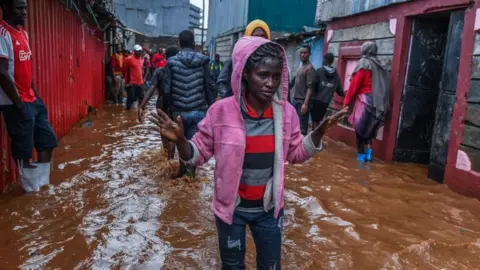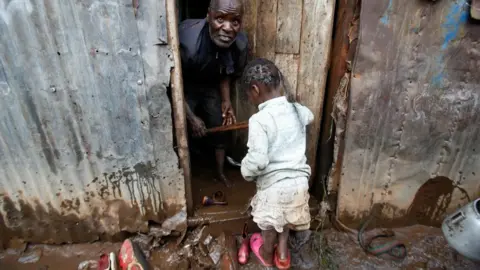By Basillioh Rukanga,
BBC News, Nairobi


Everything feels sodden in Kenya's capital, Nairobi, and beyond.
It seems as if the rain has been falling without respite for six weeks, and the impact has been devastating.
So far more than 120 people have lost their lives, including at least 50 after a dam burst on Monday a short distance from Nairobi.
This is the wet season, but the city has been experiencing far more rainfall than what is normally expected, which has been put down to the El Niño weather phenomenon.
Rivers and sewers have overflowed, roads have become waterways and homes have been destroyed.
Flooding in the city is not unusual but the sheer scale of this year's deluge has exposed longer term problems with the way Nairobi has developed.
"You can't contain nature. It doesn't work like that," Prof Alfred Omenya, an urban planning and environment expert, told the BBC.
He says that much of the city sits on top the Nairobi River's floodplain, which cuts through the capital. A number of other rivers and streams also flow through Nairobi.
A properly developed drainage system may have been able to cope, but as the city has grown over the last century from 100,000 residents to today's 4.5 million the infrastructure has not kept up.
Compounding the problem is that less than half of the residents are connected to a sewage system. In slum areas, open sewers are common, which overflow when it floods.
EPASlum settlements have been built on marginal land which is prone to flooding
Drains have also become blocked as people dispose of their household rubbish.
Open spaces have disappeared as more and more buildings have gone up - both in slums and planned areas.
As more concrete covers the earth there are fewer places to absorb the water, and it runs off - overwhelming the drains and rivers.
As a result the roads have become part of the drainage system, Prof Omenya said.
He blames "clueless leadership that started from the colonial times".
Unplanned settlements have been allowed to develop around the rivers, sometimes disrupting their natural flow.
Many of the slum areas in the city, such as Mukuru and Mathare, have been built on marginal land along river valleys.
Last Wednesday, the authorities retrieved a dozen bodies of people who had drowned in the Mathare river following heavy rains the previous evening.
In the aftermath of the downpour, most of the houses in the area were flooded, with some residents trapped on the roofs of their houses.
Upmarket estates were also hit, including some that have not been prone to flooding in the past.
The man who runs the city, Nairobi Governor Johnson Sakaja, said the rainfall levels have been very high, and blamed the encroachment on the land surrounding the rivers for the flooding crisis.
The governor has now suspended approvals for building developments and excavations.
But the bigger task might be clearing or improving the slum areas.
The government does have a plan to build affordable and decent housing, but past upgrading projects have not met the burgeoning demand.

ReutersPeople's homes have been caked in mud after water swept through them
In the meantime, residents have been asked to move to higher ground for their own safety.
President William Ruto has said that people living in dangerous areas around the country will be moved to land provided by the National Youth Service, while the government plans a long-term solution.
He said the military and the national government had been mobilised to work with counties to support those in distress.
Neighbouring Kiambu county, parts of which are on a river basin and have been affected by the floods, has also announced it will take measures to mitigate the situation, including building inspections.
In the past, buildings in and around the city have been demolished as a way to address irregular developments - but often with little effect.
Some of developments in the city and its environs have been criticised for impeding the flow of water, which then finds its way to other areas.
Construction of buildings on wetlands has also been a big problem.
In 2018, the multimillion-dollar South End Mall in Langata and the Ukay Mall in Westlands were demolished as part of a campaign to reclaim wetlands.
"Now we have many homes built next to rivers so flooded. Walls have collapsed all over… Don't go against nature. It will fight back," Robert Alai, a Nairobi county assembly legislator wrote on X, formerly Twitter.

In the meantime, residents have been asked to move to higher ground for their own safety.
President William Ruto has said that people living in dangerous areas around the country will be moved to land provided by the National Youth Service, while the government plans a long-term solution.
He said the military and the national government had been mobilised to work with counties to support those in distress.
Neighbouring Kiambu county, parts of which are on a river basin and have been affected by the floods, has also announced it will take measures to mitigate the situation, including building inspections.
In the past, buildings in and around the city have been demolished as a way to address irregular developments - but often with little effect.
Some of developments in the city and its environs have been criticised for impeding the flow of water, which then finds its way to other areas.
Construction of buildings on wetlands has also been a big problem.
In 2018, the multimillion-dollar South End Mall in Langata and the Ukay Mall in Westlands were demolished as part of a campaign to reclaim wetlands.
"Now we have many homes built next to rivers so flooded. Walls have collapsed all over… Don't go against nature. It will fight back," Robert Alai, a Nairobi county assembly legislator wrote on X, formerly Twitter.

ReutersRoads have been turned into waterways
Before the most recent floods, Mr Sakaja had defended the development of high-rise buildings in some residential areas, saying the only way Nairobi would develop was to build up.
His stance had come amid criticism that the developments were straining an already overwhelmed infrastructure. He has now issued a directive stopping all building development approvals "until we can review all those that have been issued and are continuing in the city".
A number of MPs also criticised the governor over city management, citing the sewage and flooding crisis.
Mr Sakaja has defended himself, saying the criticism was politically motivated.
Outspoken Senator Samson Cherargei from the ruling coalition said the governor was not to blame as "the problem we are having begun in 1963, you cannot resolve it now".
Some of the problems can be traced back to the origins of Nairobi - meaning a "place of cool waters" in the Maasai language - and the fact that it was not considered a suitable place for large numbers of people to live in.
It started as a railway depot under the British colonial authorities in the late 1890s. The engineers who worked on the site called the area a "swamp", with soggy land and "unsanitary conditions".
Years later, colonial official Sir Charles Eliot said Nairobi sat in "a depression with a very thin layer of soil or rock. The soil was water-logged during the greater part of the year".
Nevertheless, the city developed into an attractive city with good weather, a lot of greenery and a national park.
But its drainage problem has persisted.
An initial masterplan by the colonial authorities took into consideration the lay of the land and designed measures to prevent disasters. There have been at least two other blueprints post-independence to date - but they have mostly not been implemented.
This season's floods show that as rainfall could get more intense as a result of climate change a new plan is urgently needed, Prof Omenya said.
But the ordinary city-dweller is left mopping up, hoping that the rains subside.
Before the most recent floods, Mr Sakaja had defended the development of high-rise buildings in some residential areas, saying the only way Nairobi would develop was to build up.
His stance had come amid criticism that the developments were straining an already overwhelmed infrastructure. He has now issued a directive stopping all building development approvals "until we can review all those that have been issued and are continuing in the city".
A number of MPs also criticised the governor over city management, citing the sewage and flooding crisis.
Mr Sakaja has defended himself, saying the criticism was politically motivated.
Outspoken Senator Samson Cherargei from the ruling coalition said the governor was not to blame as "the problem we are having begun in 1963, you cannot resolve it now".
Some of the problems can be traced back to the origins of Nairobi - meaning a "place of cool waters" in the Maasai language - and the fact that it was not considered a suitable place for large numbers of people to live in.
It started as a railway depot under the British colonial authorities in the late 1890s. The engineers who worked on the site called the area a "swamp", with soggy land and "unsanitary conditions".
Years later, colonial official Sir Charles Eliot said Nairobi sat in "a depression with a very thin layer of soil or rock. The soil was water-logged during the greater part of the year".
Nevertheless, the city developed into an attractive city with good weather, a lot of greenery and a national park.
But its drainage problem has persisted.
An initial masterplan by the colonial authorities took into consideration the lay of the land and designed measures to prevent disasters. There have been at least two other blueprints post-independence to date - but they have mostly not been implemented.
This season's floods show that as rainfall could get more intense as a result of climate change a new plan is urgently needed, Prof Omenya said.
But the ordinary city-dweller is left mopping up, hoping that the rains subside.
No comments:
Post a Comment